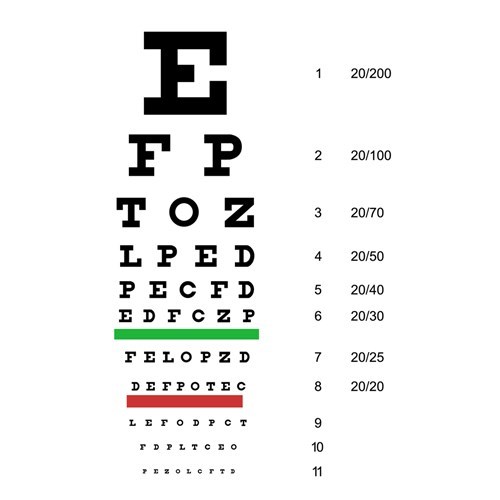What Does my Eye Prescription Mean?
27 November 2019

Understanding what your prescription actually means may feel like solving an algebraic equation, but it's actually quite simple once you get the know what the numbers, symbols and letters mean.
Don't worry - we understand it can seem quite overwhelming, which is why we've put this guide together; so there's no need to puzzle over your prescription again.
Does my prescription stay the same for glasses and contact lenses?
The short answer is: no they don’t! The optics of the lenses in glasses and contacts are slightly different. As glasses are sat on your nose, they are kept a short distance from your eyes, but contact lenses sit directly on the surface of your eye. This is why they have two different prescriptions, as the prescription you have for your glasses will not work the same if you’re looking to get contact lenses.
What does OD and OS mean?
OD and OS stand for oculus dexter and oculus sinister; which are Latin terms for right eye and left eye. Be mindful, however, that some opticians use RE (right eye) and LE (left eye) instead; much easier to understand, right?
Now the simple part is out the way, let’s get to the more complicated stuff…
What does SPH, CYL and AXIS mean?
These are the three main columns you’ll see on your prescription, which will determine how the lens needs to be made to help you see clearly.
You may also notice the words ‘prism’, ‘add’ and ‘base’ below or next to these three terms. These will only occasionally have numbers in; don’t worry, we’ll explain further down.
SPH
SPH stands for spherical. This number displays how strong the prescription needs to be. In other words, the degree of short-sight or long-sight you have.
A (+) symbol here indicates long-sightedness (hyperopia), whilst a (–) symbol indicates short-sightedness (myopia). The higher the number, the greater the prescription and therefore the stronger the lens strength required.
For example, a prescription of -1.25 is mild myopia, whereas +6.00 is high hyperopia. ‘Bad’ eyesight, or rather a stronger prescription, would be any number above -5.00 or +5.00. This means that your vision is more impaired than someone with a lower prescription.
With us so far?...
CYL
CYL stands for Cylinder. This indicates how much astigmatism you have. Some people have a (0) here, which means that the eye is perfectly spherical and there is absolutely no amount of astigmatism present, and no astigmatism correction is needed. Most people have a certain degree of astigmatism; however it is often low enough that it does not cause disruption to vision.
A higher number, such as 3 or 4, is considered significant and will affect the strength of the lens that is prescribed. Think of it like ‘extra’ prescription.
AXIS
This simply specifies the angle of the astigmatism within your prescription; measured in degrees between 1 and 180.
This number is mainly for the opticians to determine where the cylinder lies within the lens, to counteract the astigmatism.
Prism
Some patients have a muscle imbalance in their eyes. In these cases the optician will prescribe a prism, to help the eyes work better together.
Those who have double vision; a prism will help to align the two images for better vision. However, this is uncommon so this box is usually empty.
Base
If there does happen to be an imbalance in the eyes, this box is simply so the opticians know which direction the prism needs to go; for example IN, OUT, UP or DOWN.
Add
‘Add’ means reading prescription and indicates the change in power needed to correct presbyopia.
Patients over 40 years old are likely to see a number in this box. These patients will need two prescriptions; one for reading and one for distance. This may also mean there is a need for bifocal or varifocal lenses.
For those who may not know, presbyopia is the natural weakening of the eyes muscles. When this happens, our focusing ability declines and close-up objects become blurry. Brush up on your knowledge of presbyopia here.
Suitability for eye surgery
At Ultralase, the SPH and CYL are added together to determine suitability for laser eye and lens replacement surgery. This is why we ask you to bring your most recent prescription with you to your initial consultation.
Of course, the optometrist will use a range of tests and eye examinations to check the health of your eyes and suitability for surgery. A personalised treatment plan is produced for every patient!
Saying this, there are certain factors that do need to be taken into account. For example, those with a PLUS prescription (who have impaired distance vision) are required to be over the age of 35 to qualify for laser eye surgery. For these patients, implantable contact lenses or lens replacement may be more suitable.
You can use our suitability calculator yourself to find out which treatment your most in range for.

What does 20/20 vision mean?
You may notice the letters VA on your prescription; this refers to visual acuity. Visual acuity is a medical term used to quantify the clarity or sharpness of someone’s vision.
During a routine eye examination you will be asked to read from a Snellen chart. This is how visual acuity is determined.
Many people believe that 20/20 vision translates to ‘perfect’ vision- but this simply isn’t true. In actual fact 20/20 vision means average sharpness of sight. An individual who can identify the standardised 20 font letters on a Snellen chart from 20 feet away equates to 20/20 (normal) vision.
Around 75% of adults possess 20/20 vision; but it is possible to achieve better!
If an individual, for example, can read font 10 from a Snellen chart from 20ft away, they would have a visual acuity of 20/10. In other words, they have what is considered higher than average visual acuity because they can identify a smaller font size from the same distance, as someone who has 20/20 vision.
Back to Blog
